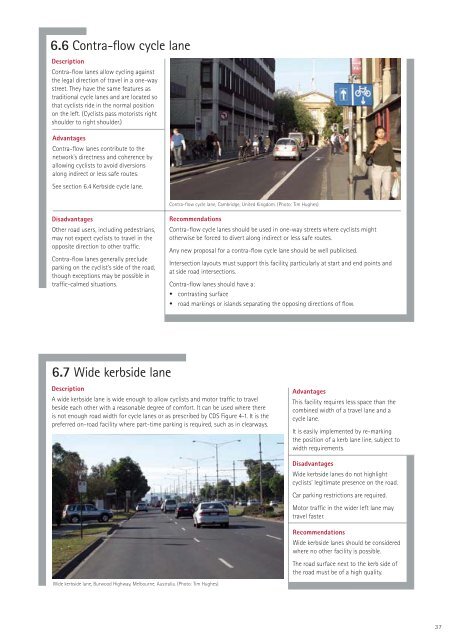Cycle network and route planning guide - NZ Transport Agency
Cycle network and route planning guide - NZ Transport Agency
Cycle network and route planning guide - NZ Transport Agency
Create successful ePaper yourself
Turn your PDF publications into a flip-book with our unique Google optimized e-Paper software.
6.6 Contra-flow cycle lane<br />
Description<br />
Contra-flow lanes allow cycling against<br />
the legal direction of travel in a one-way<br />
street. They have the same features as<br />
traditional cycle lanes <strong>and</strong> are located so<br />
that cyclists ride in the normal position<br />
on the left. (Cyclists pass motorists right<br />
shoulder to right shoulder.)<br />
Advantages<br />
Contra-flow lanes contribute to the<br />
<strong>network</strong>’s directness <strong>and</strong> coherence by<br />
allowing cyclists to avoid diversions<br />
along indirect or less safe <strong>route</strong>s.<br />
See section 6.4 Kerbside cycle lane.<br />
Contra-flow cycle lane, Cambridge, United Kingdom. (Photo: Tim Hughes)<br />
Disadvantages<br />
Other road users, including pedestrians,<br />
may not expect cyclists to travel in the<br />
opposite direction to other traffic.<br />
Contra-flow lanes generally preclude<br />
parking on the cyclist’s side of the road,<br />
though exceptions may be possible in<br />
traffic-calmed situations.<br />
Recommendations<br />
Contra-flow cycle lanes should be used in one-way streets where cyclists might<br />
otherwise be forced to divert along indirect or less safe <strong>route</strong>s.<br />
Any new proposal for a contra-flow cycle lane should be well publicised.<br />
Intersection layouts must support this facility, particularly at start <strong>and</strong> end points <strong>and</strong><br />
at side road intersections.<br />
Contra-flow lanes should have a:<br />
• contrasting surface<br />
• road markings or isl<strong>and</strong>s separating the opposing directions of flow.<br />
6.7 Wide kerbside lane<br />
Description<br />
A wide kerbside lane is wide enough to allow cyclists <strong>and</strong> motor traffic to travel<br />
beside each other with a reasonable degree of comfort. It can be used where there<br />
is not enough road width for cycle lanes or as prescribed by CDS Figure 4-1. It is the<br />
preferred on-road facility where part-time parking is required, such as in clearways.<br />
Advantages<br />
This facility requires less space than the<br />
combined width of a travel lane <strong>and</strong> a<br />
cycle lane.<br />
It is easily implemented by re-marking<br />
the position of a kerb lane line, subject to<br />
width requirements.<br />
Disadvantages<br />
Wide kerbside lanes do not highlight<br />
cyclists’ legitimate presence on the road.<br />
Car parking restrictions are required.<br />
Motor traffic in the wider left lane may<br />
travel faster.<br />
Recommendations<br />
Wide kerbside lanes should be considered<br />
where no other facility is possible.<br />
The road surface next to the kerb side of<br />
the road must be of a high quality.<br />
Wide kerbside lane, Burwood Highway, Melbourne, Australia. (Photo: Tim Hughes)<br />
37

















